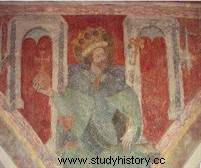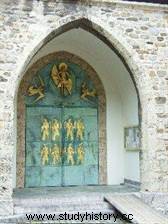 Made famous by Richard Wagner through the epic of the Nibelungs, the Burgundy kingdom and its people, however, appear no less in history as a discreet neighbor in the face of the main barbarian kingdoms. We have few sources on them. Without a chronicler such as Gregory of Tours to relate their facts, surrounded by great powers, the Burgundians show themselves too little to interest the Greek and Latin authors of Late Antiquity. Indeed, they do not ravage Gaul, they do not seize Rome, they do not kill the emperor either, they remain in the shadows and remain unknown today. Their story, although incomplete, is nevertheless rich in events and twists.
Made famous by Richard Wagner through the epic of the Nibelungs, the Burgundy kingdom and its people, however, appear no less in history as a discreet neighbor in the face of the main barbarian kingdoms. We have few sources on them. Without a chronicler such as Gregory of Tours to relate their facts, surrounded by great powers, the Burgundians show themselves too little to interest the Greek and Latin authors of Late Antiquity. Indeed, they do not ravage Gaul, they do not seize Rome, they do not kill the emperor either, they remain in the shadows and remain unknown today. Their story, although incomplete, is nevertheless rich in events and twists.
The Burgundian people
The Burgundiones are a Germanic people among many others, probably coming from the Danish island of Bornholm in the Baltic meaning etymologically "Burgundian islet" (Burgundarholm). It was Pliny the Elder the first to name them and locate them in the I st century AD east of the Oder, in present-day Poland. At the beginning of the III th century, they are this time in present-day Germany on the Elbe before settling at the end of this century on the Main, constantly waging war with their powerful and age-old enemies, the Alamanni. In 369, the Roman Emperor Valentinian allied with them against these same Alamanni.
 Around 409 they entered the Roman Empire behind the Suevi, Alans and Vandals with the will of be part of it. They thus benefit from the status of federates:in exchange for military participation, they receive land and income and retain their customs. Established in the region of Worms (Germany), they made the mistake of seeking to enlarge their territory to the detriment of the Roman Empire whose power was held by General Aetius, known as "the last of the Romans", then an ally of the Huns and of Attila.
Around 409 they entered the Roman Empire behind the Suevi, Alans and Vandals with the will of be part of it. They thus benefit from the status of federates:in exchange for military participation, they receive land and income and retain their customs. Established in the region of Worms (Germany), they made the mistake of seeking to enlarge their territory to the detriment of the Roman Empire whose power was held by General Aetius, known as "the last of the Romans", then an ally of the Huns and of Attila.
From this confrontation was born the historical heart of the legend of the Nibelungs. According to medieval accounts, the King of Burgundians, Gunther or Gondichaire had his son-in-law, the mythical Siegfried, killed. His wife Krimhild sought revenge from her second husband, Etzel who historically can represent both Aetius and Attila and who massacred the Burgundian rulers. In historical reality, let us remember that the Burgundians suffered a terrible shock and were crushed by the Huns, we would speak of 20,000 dead in the Burgundian army, including King Gondichaire in 436. The Burgundian people were reduced to a few tens of thousands of people driven out of their kingdom of Worms. These survivors migrate around Lake Geneva to establish their new home.
La Sapaudia, the foundation of the Burgundian kingdom
The survivors of the clash with the Huns led by Gondicaire's successor, Gondioc, are again integrated, at their request or by obligation, as a federated people in the Empire . Aetius settles them in Sapaudia, which etymologically is the origin of modern Savoy. This territory then corresponds to the Jura mountains and the Swiss lakes including Lake Geneva and serves as the foundation of their kingdom. With his brother Chilpéric I who took over, Gondioc grew bolder and decided to expand westward. Around 470, the Burgundians controlled the area of Vienne and Lyon, Gondioc established his court in the latter. Around 480, they went north and east to Langres and Besançon before taking the towns of the Rhone Valley as far as Provence and Avignon.
Their conquests do not seek to destroy romanization, on the contrary, they complete it. They are indeed too small in number to replace the Gallo-Roman populations in place. It is estimated that they are at most around 25,000 individuals but may be much less. They are therefore content to take key positions, to control the machinery of power without being omnipresent, sharing resources and land with the landowners and the senatorial aristocracy in place. The Burgundians thus took two-thirds of the cultivable land, one-third of the slaves and half of the houses, farms, gardens, forests and pastures in exchange for the military defense of these territories. They consider themselves for this purpose as military auxiliaries of Romaine, benefiting from the magister militum , or the title of "master of the militia of the Gauls".
Thus, if the Burgundians are Germans, they nevertheless respect the previous occupants, partially integrating into the Gallo-Roman whole. However, the two ethnic groups remain very distant. Burgundian customs sometimes clash with the refinement of the late Lower Empire. If the Romans belong to Catholicism, the Burgundians are Arian. Each ethnic group has its own code of laws.
Apogee and fall of Burgundia
At the death of Chilpéric, the Burgundian kingdom called Burgundia reached its maximum extension, going from the line of the Vosges to Avignon and it was under the reign of Gondebaud that it experienced long years of peace and tranquility. His education was made at the imperial court, he received the distinction of patrice, a high Roman dignity legitimizing the authority of the Burgundian king over his Gallo-Roman subjects. Gondebaud must nevertheless fight against the Franks and their king Clovis. The chronicler Grégoire de Tours reports a military confrontation between the two peoples around Dijon. Although defeated, Gondebaud manages to make peace with the King of the Franks, offering him his niece Clothilde in marriage. It is thus a reign of peace that he offers to his kingdom, striving throughout to calm the tensions between Arians and Catholics. And if he himself remains Arian, his son and last Burgundian king Sigismond, takes the Catholic faith from him.
 This time it is about a chaotic reign which sees the end of the Burgundian kingdom. His royal debut was marked by family violence worthy of Greek tragedies. His second wife maneuvers against the son of his first so that Sigismond kills him by mistake, which attracts the wrath of his powerful neighbors and leads him to go to penance at the monastery of Agaune which he had founded. Sigismund must then fight the Franks again. One of the sons of Clovis, Clodomir, King of Orléans decides to attack the Burgundian kingdom and has Sigismond assassinated. His brother Gondomar resumed the fight against Clodomir and defeated him in 524, but it was only a respite before the kingdom fell into the hands of the Franks who shared it in 534.
This time it is about a chaotic reign which sees the end of the Burgundian kingdom. His royal debut was marked by family violence worthy of Greek tragedies. His second wife maneuvers against the son of his first so that Sigismond kills him by mistake, which attracts the wrath of his powerful neighbors and leads him to go to penance at the monastery of Agaune which he had founded. Sigismund must then fight the Franks again. One of the sons of Clovis, Clodomir, King of Orléans decides to attack the Burgundian kingdom and has Sigismond assassinated. His brother Gondomar resumed the fight against Clodomir and defeated him in 524, but it was only a respite before the kingdom fell into the hands of the Franks who shared it in 534.
It was the end of the Burgundian dynasty and of this kingdom which lasted barely a century, but not for all that of Burgondia which continued to exist in the very heart of the Frankish kingdom, leaving the next birth of the Duchy of Burgundy under the Merovingian kings.
Bibliography
- Justin Favrod, Les Burgondes. A forgotten kingdom in the heart of Europe, Polytechnic and university press, 2002.
- Jean Richard (dir.), History of Burgundy, Éditions Privat, 1988.
